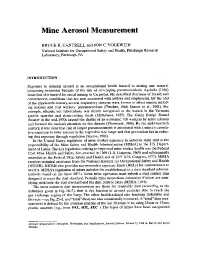Mining Publication: Mine Aerosol Measurement
Original creation date: September 2001
Exposure to mineral aerosol is an occupational health hazard in mining and mineral processing industries because of the risk of developing pneumoconiosis. Agricola (1556) described this hazard for metal mining in Carpathia. He described shortness of breath and consumption, conditions that are now associated with asthma and emphysema. By the end of the nineteenth century, several respiratory diseases were known to affect miners, including silicosis and coal workers' pneumoconiosis (Fletcher, 1948; Seaton et al., 1981). For example, silicosis, not tuberculosis, was clearly recognized as the hazard in the Vermont granite quarries and stone-cutting sheds (McFarland, 1927). The Gauly Bridge Tunnel disaster in the mid-1930s caused the deaths of an estimated 700 workers by acute silicosis and focused the nation's attention on this disease (Cherniack, 1986). By the mid-twentieth century, it was clear that risk of simple pneumoconiosis is associated with a miner's cumulative exposure to mine aerosol in the respirable size range and that prevention lies in reducing that exposure through regulation (Seaton, 1986).
Authors: BK Cantrell, JC Volkwein
Conference Paper - September 2001
NIOSHTIC2 Number: 20021272
In: Baron PA, Klaus W, eds. Aerosol Measurement: Principles, Techniques, and Applications, 2nd Edition, 2001 Sep; :801-820
See Also
- Best Practices for Controlling Respirable Dust in Coal Mines
- Characterizing Exposures to Airborne Metals and Nanoparticle Emissions in a Refinery
- Coal Dust Explosibility Meter Evaluation and Recommendations for Application
- Comparing Measurements of Carbon in Diesel Exhaust Aerosols Using the Aethalometer, NIOSH Method 5040, and SMPS
- In-depth Survey Report: Control Technology for Environmental Enclosures - The Effect of Wind Speed Upon Aerosol Penetration Into an Enclosure at Clean Air Filter, Defiance, IA
- Overlap Probability for Short-Period-Delay Detonators Used in Underground Coal Mining
- A Review of Occupational Silica Exposures on Continuous Mining Operations
- Silica Adds to Respirable Dust Concerns: What If You Could Know the Silica Dust Levels in a Coal Mine After Every Shift?
- Technology News 497 - "You Are My Sunshine": A New Video Release From NIOSH on the Sunshine Mine Fire
- Using Persuasive Messages to Encourage Voluntary Hearing Protection Among Coal Miners
- Page last reviewed: 9/21/2012
- Page last updated: 9/21/2012
- Content source: National Institute for Occupational Safety and Health, Mining Program


 ShareCompartir
ShareCompartir
